Holy water
Holy water is water that has been blessed by a member of the clergy or a religious figure. The use for cleansing prior to a baptism and spiritual cleansing is common in several religions, from Christianity to Sikhism. The use of holy water as a sacramental for protection against evil is common among Lutherans, Anglicans, Roman Catholics,[1][2] and Eastern Christians.
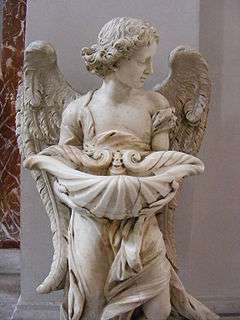
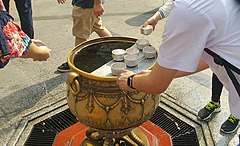
In Christianity
In Catholicism, Lutheranism, Anglicanism, Eastern Orthodoxy, Oriental Orthodoxy and some other churches, holy water is water that has been sanctified by a priest for the purpose of baptism, the blessing of persons, places, and objects, or as a means of repelling evil.[3][4]
History
The Apostolic Constitutions, which goes back to about the year 400, attribute the precept of using holy water to the Apostle Matthew. It is plausible that in earliest Christian times water was used for expiatory and purificatory purposes in a way analogous to its employment in Jewish Law.("And he shall take holy water in an earthen vessel, and he shall cast a little earth of the pavement of the tabernacle into it"[Numbers 5:17]). Yet, in many cases, the water used for the sacrament of Baptism was flowing water, sea or river water, and it could not receive the same blessing as that contained in the baptisteries in the view of the Roman Catholic church.[5] However, Eastern Orthodox do perform the same blessing, whether in a baptistery or an outdoor body of water.
Use and storage
Sprinkling with holy water is used as a sacramental that recalls baptism.[6] In the West the blessing of the water is traditionally accompanied by exorcism and by the addition of exorcized and blessed salt.[7]
Holy water is kept in the holy water font, which is typically located at the entrance to the church (or sometimes in a separate room or building called a baptistery). Smaller vessels, called stoups, are usually placed at the entrances of the church, to enable people to sprinkle themselves with it on entering. In recent years, with the concerns over influenza, new holy water machines that work like an automatic soap dispenser have become popular.[8]
In the Middle Ages the power of holy water was considered so great that in some places fonts had locked covers to prevent the theft of holy water for unauthorized magic practices. The Constitutions of Archbishop Edmund Rich (1236) prescribe that: "Fonts are to be kept under lock and key, because of witchcraft (sortilege). Similarly the chrism and sacred oil are kept locked up."[9]
Proper disposal
In Catholicism, holy water, as well as water used during the washing of the priest's hands at Mass, is not allowed to be disposed of in regular plumbing. Roman Catholic churches will usually have a special basin (a Sacrarium) that leads directly into the ground for the purpose of proper disposal. A hinged lid is kept over the holy water basin to distinguish it from a regular sink basin, which is often just beside it. Items that contained holy water are separated, drained of the holy water, and then washed in a regular manner in the adjacent sink.[10]
Hygiene
Holy water fonts have been identified as a potential source of bacterial and viral infection. In the late 19th century, bacteriologists found staphylococci, streptococci, coli bacilli, Loeffler's bacillus, and other bacteria in samples of holy water taken from a church in Sassari, Italy.[11] In a study performed in 1995, 13 samples were taken when a burn patient acquired a bacterial infection after exposure to holy water. The samples in that study were shown to have a "wide range of bacterial species", some of which could cause infection in humans.[12] During the swine flu epidemic of 2009, Bishop John Steinbock of Fresno, California, recommended that "holy water should not be in the fonts" due to fear of spreading infections.[13] Also in response to the swine flu, an automatic, motion-detecting holy water dispenser was invented and installed in an Italian church in 2009.[14]
Christian traditions
Roman Catholics
Sacramental and sanctification
A blessing is, as a prayer,[15] a sacramental.[16] By blessing water, Catholic priests praise God and ask him for his grace.[15] Intended as a reminder of baptism, Catholic Christians dip their fingers in the holy water and make the sign of the cross when entering the church.
Fr. John F. Sullivan, writing in the early twentieth century, noted that, "Besides the pouring of baptismal water ... the sprinkling with holy water is a part of the ceremonies of Matrimony, of Extreme Unction and of the administration of the Holy Eucharist to the sick, and it is employed also in services for the dead."[17] The Sunday liturgy may begin with the Rite of Blessing and Sprinkling Holy Water, in which holy water is sprinkled upon the congregation; this is called aspersion, from the Latin, aspergere, to sprinkle. This ceremony dates back to the ninth century. An aspergill or aspergillum is a brush or branch used to sprinkle the water. An aspersorium is the vessel which holds the holy water and into which the aspergillum is dipped, though elaborate Ottonian examples are known as situlae. Blessed salt may be added to the water "where it is customary."
This use of holy water and making a sign of the cross when entering a church reflects a renewal of baptism, a cleansing of venial sin, as well as providing protection against evil.[18] It is sometimes accompanied by the following prayer:[19]
By this Holy water and by your Precious Blood, wash away all my sins O Lord.
Although not actually holy water since it has not been blessed by a priest, some Catholics believe that water from specific shrines, such as Lourdes, can bring healing.[20]
Formula
The traditional Latin formula for blessing the water is as follows:
Exorcizo te, creatura aquæ, in nomine Dei Patris omnipotentis, et in nomine Jesu Christi, Filii ejus Domini nostri, et in virtute Spiritus Sancti: ut fias aqua exorcizata ad effugandam omnem potestatem inimici, et ipsum inimicum eradicare et explantare valeas cum angelis suis apostaticis, per virtutem ejusdem Domini nostri Jesu Christi: qui venturus est judicare vivos et mortuos et sæculum per ignem. Deus, qui ad salutem humani generis maxima quæque sacramenta in aquarum substantia condidisti: adesto propitius invocationibus nostris, et elemento huic, multimodis purificationibus præparato, virtutem tuæ benedictionis infunde; ut creatura tua, mysteriis tuis serviens, ad abigendos dæmones morbosque pellendos divinæ gratiæ sumat effectum; ut quidquid in domibus vel in locis fidelium hæc unda resperserit careat omni immunditia, liberetur a noxa. Non illic resideat spiritus pestilens, non aura corrumpens: discedant omnes insidiæ latentis inimici; et si quid est quod aut incolumitati habitantium invidet aut quieti, aspersione hujus aquæ effugiat: ut salubritas, per invocationem sancti tui nominis expetita, ab omnibus sit impugnationibus defensa. Per Dominum, amen.
There are three current formulas for blessing the water which a priest may choose from to use. They are as follows:[21]
V. Blessed are you, Lord, all-powerful God, who in Christ, the living water of salvation, blessed and transformed us. Grant that when we are sprinkled with this water or make use of it, we will be refreshed inwardly by the power of the Holy Spirit and continue to walk in the new life we received at Baptism. We ask this though Christ our Lord. R. Amen.
V. Lord, holy Father, look with kindness on your children redeemed by your Son and born to a new life by water and the Holy Spirit. Grant that those who are sprinkled with this water may be renewed in body and spirit and may make a pure offering of their service to you. We ask this through Christ our Lord. R. Amen.
V. O God, the Creator of all things, by water and the Holy Spirit you have given the universe its beauty and fashioned us in your own image. R. Bless and purify your Church. V. O Christ the Lord, from your pierced side you gave us your sacraments as fountains of salvation. R. Bless and purify your Church. V. Priest: O Holy Spirit, giver of life, from the baptismal font of the Church you have formed us into a new creation in the waters of rebirth. R. Bless and purify your Church.
Protection against evil

In his book The Externals of the Catholic Church, originally published in 1917, Fr. John F. Sullivan writes, "The prayers said over the water are addressed to the Father, the Son, and the Holy Ghost, that through the power of the Blessed Trinity the spirits of evil may be utterly expelled from this world and lose all influence over mankind. Then God is besought to bless the water, that it may be effective in driving out devils and in curing diseases; that wherever it is sprinkled there may be freedom from pestilence and from the snares of Satan."[22]
Catholic saints have written about the power of holy water as a force that repels evil. Saint Teresa of Avila, a Doctor of the Church who reported visions of Jesus and Mary, was a strong believer in the power of holy water and wrote that she used it with success to repel evil and temptations.[23] She wrote:
I know by frequent experience that there is nothing which puts the devils to flight like Holy water.[24]
The twentieth-century nun and mystic Saint Faustina in her diary (paragraph 601) said she once sprinkled a dying sister with holy water to drive away demons. Although this was wrong to do, since it was the priest's duty, she remarked, "holy water is indeed of great help to the dying."[25]
In Holy Water and Its Significance for Catholics, Cistercian priest Henry Theiler states that in addition to being a strong force in repelling evil, holy water has the twofold benefit of providing grace for both body and soul.[26]
The new Rituale Romanum excludes the exorcism prayer on the water. Exorcized and blessed salt has traditionally been added to the holy Water as well. Priests can continue to use the older form if they wish as confirmed by Pope Benedict XVI in Summorum Pontificum, which states "What earlier generations held as sacred, remains sacred and great for us too".[27]
Eastern Christians
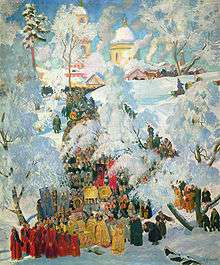

Among the Eastern Orthodox and the Byzantine Rite Catholics holy water is used frequently in rites of blessing and exorcism, and the water for baptism is always sanctified with a special blessing.
There are two rites for blessing holy water: the "Great Blessing of Waters" which is held on the Feast of Theophany and at baptisms, and the "Lesser Blessing of Waters" which is conducted according to need and local custom during the rest of the year, certain feast days calling for the Lesser Blessing of Waters as part of their liturgical observance. Both forms are based upon the Rite of Baptism. After the blessing of holy water the faithful are sprinkled with it and each drinks some of it.
Holy water is drunk by the faithful after it is blessed and it is a common custom for the pious to drink holy water every morning. In the monasteries of Mount Athos holy water is always drunk in conjunction with consuming antidoron. Eastern Orthodox do not typically bless themselves with holy water upon entering a church as Western Catholics do, but a quantity of holy water is often kept in a font placed in the narthex (entrance) of the church, available for anyone who would like to partake of it or to take some of it home.
After the annual Great Blessing of Waters at Theophany (also known as Epiphany), the priest goes to the homes of the faithful within his parish and, in predominantly Orthodox lands, to the buildings throughout town, and blesses them with holy water.
When blessing objects such as the palms on Palm Sunday, Paschal eggs and other foods for Easter, candles, or liturgical instruments and sacred vessels (icons and crosses are not blessed, however, as they are considered intrinsically holy and redeemed), the blessing is completed by a triple sprinkling with holy water using the words, "This (name of item) is blessed by the sprinkling of this holy water, in the name of the Father, and of the Son, and of the Holy Spirit."
Throughout the centuries, there have been many springs of water that have been believed by members of the Orthodox Church to be miraculous. Some still flow, such as the one at Pochaev Lavra in Ukraine, and the Life-Giving Spring of the Theotokos in Constantinople (commemorated on Bright Friday).
Anglicans
Although Holy water is not a term used in official rites of the Church of England, font water is sanctified in the Church of England baptism rite.[28] In contrast, the Episcopal Church (United States) does expressly mention the optional use of holy water in some recent liturgies of blessing.[29] More generally, the use of water within High Church Anglicanism or Anglo-Catholicism adheres closely to Roman Catholic practice. In many Anglican churches baptismal water is used for the asperges.[30][31] A widely-used Anglo-Catholic manual, Ritual Notes, first published by A. R. Mowbray in 1894, discusses the blessing and use of holy water. In addition to "the pious custom" of blessing oneself on entering and leaving a church "in memory of our baptism and in token of the purity of heart with which we should worship Almighty God", the book commends that, "Holy water should be obtained from the parish priest, may be (and indeed should be) taken away and kept for use privately by the faithful in their homes."[32] An English translation of the traditional rite for the blessing of water and salt, including the exorcisms, was included in the Anglican Missal.[33] Shorter forms are found in A Priest's Handbook by Dennis G. Michno,[34] and Ceremonies of the Eucharist by Howard E. Galley.[35] Some parishes use a stoup, basin, or font to make holy water available for the faithful to use in blessing themselves, making the sign of the cross upon entering the church.[36]
In the Book of Occasional Services of the Episcopal Church (United States), in the rite for Restoring of Things Profaned, the bishop or priest while processing around the church or chapel recite Psalm 118 with the antiphon Vidi aquam:
I saw water proceeding out of the temple; from the right side it flowed, alleluia; and all those to whom that water came shall be saved, and shall say, alleluia, alleluia.
A rubric directs that as each profaned object is addressed, "it may be symbolically cleansed by the use of signs of purification, such as water or incense."[37]
Lutherans
The use of holy water in some synods of Lutheranism is for the baptism of infants and new members of the church. The water is believed to be blessed by God, as it is used in a sacrament. The water is applied to the forehead of the laity being baptised and the minister performs the sign of the cross. Lutherans tend to have baptismal water fonts near the entrance of the church.[38]
Other synods do not use holy water, however they do typically treat the water used for baptisms in a more respectful manner.
Methodists
In the Methodist tradition, Holy Baptism is often administered by sprinkling or pouring holy water over the candidate.[39] The official Baptismal Liturgy, as well as the liturgy for Reaffirmation of Baptism commonly done through asperges, has a prayer for the blessing of this water:[40]
Pour out your Holy Spirit, to bless this gift of water and those who receive it, to wash away their sin and clothe them in righteousness throughout their lives, that, dying and being raised with Christ, they may share in his final victory. All praise to you, Eternal Father, through your Son Jesus Christ, who with you and the Holy Spirit lives and reigns for ever. Amen.[41]
Other religions
Sikhism
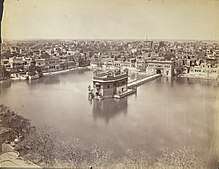
One of the holiest sites in Sikhism, Harmandir Sahib, is surrounded by a pool of water called amritsar or amritsarovar. For those who wish to take a dip in the pool, the Temple provides a half hexagonal shelter and holy steps to Har ki Pauri. Bathing in the pool is believed by many Sikhs to have restorative powers, purifying one's karma. Some carry bottles of the pool water home particularly for sick friends and relatives. The pool is maintained by volunteers who perform kar seva (community service) by draining and desilting it periodically.
Sikhs use the Punjabi term amrita (ਅੰਮ੍ਰਿਤ) for the holy water used in the baptism ceremony known as Amrit Sanskar or Amrit Chhakhna.[42]
Hinduism
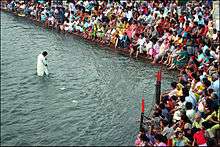
In Hinduism, water represents God in a spiritual sense which is the central theme in Mantra Pushpam from Taithreeya Aranyakam of Yajur Veda. Bathing in holy water is, thus, a key element in Hinduism, and the Ganges is considered the holiest Hindu river.[43]
Buddhism
The idea of "blessed water" is used in virtually all Buddhist traditions. In the Theravada tradition, water is put into a new pot and kept near a Paritrana ceremony, a blessing for protection. This "lustral water" can be created in a ceremony in which the burning and extinction of a candle above the water represents the elements of earth, fire, and air.[44] This water is later given to the people to be kept in their home. Not only water but also oil and strings are blessed in this ceremony. Most Mahayana Buddhists typically recite sutras or various mantras (typically that of the bodhisattva Avalokitesvara for example) numerous times over the water, which is then either consumed or is used to bless homes afterwards. In Vajrayana Buddhism, a Bumpa, a ritual object, is one of the Ashtamangala, used for storing sacred water sometimes, symbolizing wisdom and long life.[45][46]
Islam

The Sunni Muslim variety of holy water is the Zamzam water that comes from a spring by The Kaaba.

The drinking of "healing water" (āb-i shifā) is a practice in various denominations of Shia Islam.[47] In the tradition of the Twelver Shi’a, many dissolve the dust of sacred locations such as Karbala (khāk-i shifa) and Najaf and drink the water (āb-i shifā) as a cure for illness, both spiritual and physical.[47]
The Ismaili tradition involves the practice of drinking water blessed by the Imam of the time. This water is taken in the name of the Imam and has a deep spiritual significance. This is evident from the names used to designate the water, including light (nūr) and ambrosia (amṛt, amī, amīras, amījal). This practice is recorded from the 13th and 14th centuries and continues to the present day. The ceremony is known as ghat-pat in South Asia.[47]
Others
In Ancient Greek religion, holy water called chernips (Greek: χέρνιψ) was created when a torch from a religious shrine was extinguished in it. In Greek religion, purifying people and locations with water was part of the process of distinguishing the sacred from the profane.[48]
The Book of Numbers mentions using water in a test for the purity of a wife accused of marital infidelity.[49] Known as the Ordeal of the Bitter Water, the accused woman (sotah) would first be asked to confess to her crime before the court. If she refused to confess, she would then undergo the ritual. She would be stripped naked and then drink a mixture of water and dust. If she was guilty, the text is unclear on the exact punishment. If she was innocent, there would be no effect.[50]
In Wicca and other ceremonial magic traditions, a bowl of salt is blessed and a small amount is stirred into a bowl of water that has been ritually purified. In some traditions of Wicca, this mixture of water and salt symbolizes the brine of the sea, which is regarded as the womb of the Goddess, and the source of all life on Earth. The mixture is consecrated and used in many religious ceremonies and magical rituals.[51]
Unofficial uses
Holy water has also been believed to ward off or act as a weapon against mythical evil creatures, such as vampires. In eastern Europe, one might sprinkle holy water onto the corpse of a suspected vampire in order to destroy it or render it inert.[52][53] Thereafter, the concept proliferated into fiction about such creatures.
In popular culture, holy water has been used as an exotic material with connotations of luxury. In 2019 an unauthorized collaboration between Nike and the Vatican by creative collective MSCHF produced Jesus Shoes with soles filled with holy water, allowing the wearer to "walk on water".[54]
Gallery
- Stoups
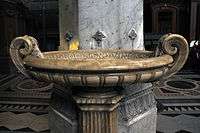 Basilica of Notre-Dame de Fourvière, Lyon, France
Basilica of Notre-Dame de Fourvière, Lyon, France_-_Facade_-_Stoup.jpg) Church of Santa Maria a Cintoia, Florence, Italy
Church of Santa Maria a Cintoia, Florence, Italy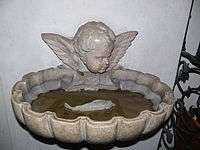 Church of Saints Saint Cajetan and Maximillian, Salzburg, Austria
Church of Saints Saint Cajetan and Maximillian, Salzburg, Austria
References
- "Tracts on Principles of Divine Worship: No. 3. The Sprinkling of Holy Water". New York: Men's Guild, St. Ignatius' Church. Retrieved 13 January 2013.
Holy water has no power to beautify the soul here in time and the body in eternity, as Penance and the Eucharist have; but for those who reverently use it, having the right dispositions of faith and contrition, it has power to banish demons, dispel their deceits and vexations, cleanse the soul from stain of venial sins, avert earthly ills (other than those which God allows for our good), and to promote our temporal welfare.
- Theiler, Henry (1909). Holy Water and Its Significance for Catholics. Ratisbon, New York: F. Puster & Co. Reprint: Sophia Institute Press, 2016. ISBN 0-7661-7553-7 pp. 13-15.
- Chambers's encyclopædia (1870). Philadelphia: Lippincott & Co. p. 374.
- Nathaniel Altman, 2002 Sacred water: the spiritual source of life ISBN 1-58768-013-0 pp 130–133
- "CATHOLIC ENCYCLOPEDIA: Holy Water". www.newadvent.org. Retrieved 2020-08-11.
- Catechism of the Catholic Church, Sacramentals, ss. 1667, 1668
- The New International Dictionary of the Christian Church (1974). J. D. Douglas (ed.). "Holy Water". Grand Rapids: Zondervan. p. 478.
- "Hi-tech holy water calms flu fear". BBC News. 11 November 2009. Retrieved 17 May 2012.
- Fontes sub serura clausi teneantur, propter saortilegia. Chrisma similiter et oleum sacrum sub clave custodiantur" (Wilkinson, Consilia, 1:636, quoted in George C. Homans, English Villagers in the Thirteenth Century, 2nd ed. 1991:384 and note 2).
- Theiler, Henry (1909). Holy Water and Its Significance for Catholics. Ratisbon, New York: F. Puster & Co. Reprint: Sophia Institute Press, 2016. ISBN 0-7661-7553-7 p. 48.
- Dietetic and Hygienic Gazette, Volume 14, page 578. The Gazette Publishing Company, 1898.
- J.C. Rees and K.D. Allen, 1996 "Holy water—a risk factor for hospital-acquired infection". Journal of Hospital Infection 32(1), pages 51–55.
- California Catholic Daily. "Holy water should not be in fonts during this epidemic <Internet>". 4 May 2009.
- NPR Morning Edition. "In Italy, An Automatic Holy-Water Dispenser <Internet>". 12 November 2009.
- "Catechism of the Catholic Church - In the age of the Church". www.vatican.va. Retrieved 2020-08-11.
- "Catechism of the Catholic Church - Sacramentals". www.vatican.va. Retrieved 2020-08-11.
- Sullivan, John F. (1917). The Externals of the Catholic Church. New York: P. J. Kennedy. Reprint: New York: Nine Choirs Press, 2010. ISBN 9780615370958 p. 167.
- Bold, Philip (1896). Catholic Doctrine and Discipline Simply Explained. Rev. and ed. by William H. Eyre. London: Kegan Paul, Trench, Trübner. Reprint: Kessinger Publishing, 2010. ISBN 9781164098683 page 283.
- Jacquelyn Lindsey, 2001 Catholic Family Prayer Book OSV Press ISBN 0-87973-999-1 p.65
- Richard Clarke, 2008 Lourdes, Its Inhabitants, Its Pilgrims, And Its Miracles ISBN 1-4086-8541-8 page 38
- "Blessing of Holy Water Outside of Mass". Catholic News Agency. Retrieved 2020-08-11.
- Sullivan, John F. (1917). The Externals of the Catholic Church. New York: P. J. Kennedy. Reprint: New York: Nine Choirs Press, 2010. ISBN 9780615370958 p. 166.
- Tessa Bielecki, Mirabai Starr, 2008 Teresa of Avila: The Book of My Life ISBN 1-59030-573-6 pp 238–241
- Teresa of Avila, 2008 Life of St. Teresa of Jesus ISBN 1-60680-041-8 page 246
- Liturgical Year: Divine Mercy In My Soul
- Theiler, Henry (1909). Holy Water and Its Significance for Catholics. Ratisbon, New York: F. Puster & Co. Reprint: Sophia Institute Press, 2016. ISBN 0-7661-7553-7 pp. 24–31.
- Legionary of Christ Father Edward McNamara. "Extraordinary Form; Book of Blessings". ZENIT.
- Church of England Rite of Holy Baptism, The Archbishops' Council of the Church of England, 2000–2006
- Enriching Our Worship 5: Liturgies and Prayers Related to Childbearing, Childbirth, and Loss; Church Publishing; 2009; p. 20.
- "Anglican Service Book--The Asperges and the Vidi Aquam". justus.anglican.org. Retrieved 2020-08-11.
- Michno, Dennis G. (1998) [1983]. A Priest's Handbook: The Ceremonies of the Church. (3rd ed.) Harrisburg, PA; New York: Morehouse Publishing. ISBN 9780819217684 p. 209.
- Ritual Notes: A Comprehensive Guide to the Rites and Ceremonies of the Book of Common Prayer of the English Church. (1926) [1894]. London: W. Knott & Son. (7th ed.) p.59. A tenth edition was published in 1956, and an eleventh edition in 1964.
- Anglican Missal in the American Edition (1961). "The Order of Blessing Water." Mount Sinai, New York: Frank Gavin Liturgical Foundation. pp.238-240.
- Michno, Dennis G. (1998) [1983]. A Priest's Handbook: The Ceremonies of the Church. "A Form for Blessing Holy Water." (3rd ed.) Harrisburg; New York: Morehouse Publishing. p. 266. ISBN 9780819217684
- Galley, Howard E. (1989). Ceremonies of the Eucharist. "The Setting Apart of Lustral Water." Cambridge, MA: Cowley Publications. p. 232.
- An Episcopal Dictionary of the Church. Armentrout, Don S.; Slocum, Robert Boak (eds.) (2000). "Holy Water". New York: Church Publishing. ISBN 9780898697018
- The Episcopal Church (United States) (1991). The Book of Occasional Services. "Restoring of Things Profaned". New York: Church Hymnal Corporation. p. 217. ISBN 0-89869-227-X
- Getz, Keith (February 2013). "Where is the Baptismal Font?" (PDF). Evangelical Lutheran Church in America. Retrieved 5 May 2014.
By having the font at the entrance of the church, and using the font every Sunday, we are intentionally and dramatically revealing the importance of Holy Baptism and highlighting it as foundational to our life in Christ. It symbolically reminds us that we enter into the life of the church, into the life of Christ’s body, through the birthing waters of the baptismal font, where we are born again from above. Dipping our fingers in the holy water of the font and making the sign of the cross, reinforces who and whose we are. We are reminded that we have been baptized; daily we die to sin and rise to new life in the Spirit. The font is also positioned so that from the font there is a direct and central path leading to the altar, highlighting how these two Holy Sacraments are intimately connected. As we leave the church, we see the baptismal font, reminding us that we have been baptized, named and claimed, to serve others in proclamation and service to others.
- Hannon, Dan (2014). "Baptism". Life Events. The United Methodist Church.
Holy Baptism is a Covenant between an individual and God. It is God’s word to us, proclaiming our adoption by grace and our word to God, promising our response of faith and love. Persons of all ages can be baptized at Christ Church. We baptize by sprinkling Holy Water. The United Methodist Church recognizes baptisms from other denominations and churches and therefore does not “re-baptize”.
Missing or empty|url=(help) - "This is your Baptismal Liturgy: A Resource for Understanding The United Methodist Ritual of Holy Baptism". The United Methodist Church. 2001.
Holy Spirit is invoked to bless and use the water, in anticipation that God will act again, even now.
Missing or empty|url=(help) - "This is your Baptismal Liturgy: A Resource for Understanding The United Methodist Ritual of Holy Baptism". The United Methodist Church. 2001. Missing or empty
|url=(help) - Sikhism, 2004, by Geoff Teece ISBN 1-58340-469-4 page 7
- Hinduism, 2004, by Geoff Teece ISBN 1-58340-466-X page 22
- "Buddhism in Thailand: Lustral Water".
- Smithsonian Institution. "Buddhist ritual sprinkler (kundika) <Internet>". Archived from the original on 21 June 2007. Retrieved 16 July 2007.
- The British Museum. "Stoneware kundika (water sprinkler) <Internet>". Archived from the original on 27 September 2007. Retrieved 16 July 2007.
- Virani, Shafique. The Ismailis in the Middle Ages: A History of Survival, A Search for Salvation (New York: Oxford University Press), 2007, pp. 107–108.
- Greek religion: archaic and classical, by Walter Burkert, John Raffan 1991 ISBN 0-631-15624-0 page 77
- Numbers 5:12–31
- Biale, Rachel (1995). Women and Jewish Law: The Essential Texts, Their History, and Their Relevance for Today. Random House Digital. p. 186. ISBN 0805210490.
- Wicca for Life: The Way of the Craft -- From Birth to Summerland, 2003, by Raymond Buckland ISBN 0-8065-2455-3 page 85
- Bonnerjea, Biren. A Dictionary of Superstitions and Mythology, Folk Press Limited, 1927, p. 242. Archived 2014-03-14 at the Wayback Machine
- Library of universal knowledge: A reprint of the last (1880) Edinburgh and London edition of Chambers' encyclopaedia, with copious additions by American editors, Volume 14. American Book Exchange (Original from Harvard University), 1881, p. 804.
- Law, Jeannie. “$3,000 'Jesus Shoes' Injected with Holy Water from Jordan River Sell out in Minutes.” The Christian Post, 10 Oct. 2019 [www.christianpost.com/news/3000-jesus-shoes-injected-with-holy-water-from-jordan-river-sell-out-in-minutes.html]
Further reading
- (Mother) Mary; Ware, (Archimandrite) Kallistos (Tr.)(1998). The Festal Menaion (reprint), pp 348–359. South Canaan: St. Tikhon's Seminary Press. ISBN 1-878997-00-9.
- Isabel Florence Hapgood (Tr., ed.)(1983). Service Book of the Holy Orthodox-Catholic Apostolic Church (6th ed.), pp 189–197. Englewood: Antiochian Orthodox Christian Archdiocese.
- Collectio Rituum ad instar appendicis Ritualis Romani pro dioecesibus Statuum Foederatorum Americae Septentrionalis. Milwaukee: Bruce (1954)
External links
- On Holy Water blessed at Theophany by St. John of Shanghai and San Francisco (Eastern Orthodox)
- Holy Water from various Churches
- Photo of Great Blessing of Waters at Theophany (Russian Orthodox)
- Photo of Lesser Blessing of Waters (Russian Orthodox)
- St Brigid's Well, County Kildare